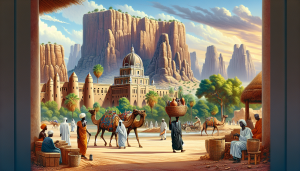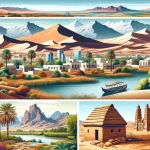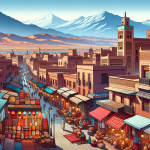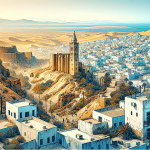Exploring the Rich Tapestry of Mali: A Journey Through History, Culture, and Natural Beauty
Mali, a landlocked country in West Africa, offers a captivating blend of history, culture, and natural beauty that beckons travelers from around the globe. Known for its ancient cities, vibrant traditions, and breathtaking landscapes, Mali is a destination that promises to enchant and inspire. From the legendary city of Timbuktu, which was once a major center of learning and commerce, to the stunning cliffs of Bandiagara, home to the Dogon people, Mali is a treasure trove of experiences waiting to be discovered. Whether you’re an adventurer seeking the thrill of the Sahara Desert, a history buff eager to explore ancient manuscripts, or a cultural enthusiast wanting to immerse yourself in local festivals, Mali has something to offer. In this article, we’ll delve into the myriad attractions and experiences that make Mali a unique and unforgettable destination. By the end, you’ll understand why this remarkable country should be on every traveler’s bucket list.
The Historical and Cultural Significance of Mali
Mali’s history is as rich and diverse as its landscape. The country was once home to three of Africa’s greatest empires: the Ghana Empire, the Mali Empire, and the Songhai Empire. These empires were not only powerful but also centers of trade, learning, and culture. The Mali Empire, in particular, is renowned for its wealth and influence during the reign of Mansa Musa, who is often considered the richest person in history. His pilgrimage to Mecca in 1324, accompanied by a lavish entourage and vast amounts of gold, left a lasting impression on the Islamic world and beyond.
Timbuktu: The Jewel of the Sahara
No discussion about Mali’s historical significance would be complete without mentioning Timbuktu. This legendary city, founded in the 12th century, became a major center of learning and trade in the 14th and 15th centuries. Timbuktu’s universities and libraries attracted scholars from across the Islamic world, making it a beacon of knowledge and culture. Today, visitors can explore the city’s ancient mosques, such as the Djinguereber Mosque, and view some of the thousands of manuscripts that have survived the passage of time. Walking through the streets of Timbuktu, one can almost feel the echoes of its glorious past.
Djenné: A Living UNESCO World Heritage Site
Another city of great historical and cultural importance is Djenné. Founded in the 9th century, Djenné is one of the oldest cities in sub-Saharan Africa. The city is best known for its stunning Great Mosque, the largest mud-brick building in the world and a UNESCO World Heritage Site. The mosque’s annual maintenance, known as the “Crepissage de la Grande Mosquée,” is a community event that involves the entire city. This tradition not only preserves the mosque but also strengthens social bonds and cultural identity. Exploring Djenné offers a glimpse into Mali’s rich architectural and spiritual heritage.
The Natural Wonders of Mali
Mali’s natural landscapes are as diverse as its cultural heritage. From the arid expanses of the Sahara Desert to the lush plains of the Niger River, the country’s geography offers a wide range of experiences for nature lovers.
The Sahara Desert: An Adventurer’s Playground
The Sahara Desert, which stretches across northern Mali, is a vast and mesmerizing landscape of sand dunes, rocky plateaus, and oases. For those seeking adventure, the Sahara offers a range of activities, from camel treks to off-road expeditions. The desert’s stark beauty and otherworldly silence create a sense of awe and wonder. Visiting the Sahara also provides an opportunity to learn about the Tuareg people, who have adapted to this harsh environment for centuries. Their culture, traditions, and craftsmanship add a unique dimension to the desert experience.
The Cliffs of Bandiagara: A Cultural and Natural Marvel
In central Mali, the Bandiagara Escarpment, also known as the Cliffs of Bandiagara, is a UNESCO World Heritage Site that combines natural beauty with cultural significance. The cliffs rise dramatically from the surrounding plains, creating a stunning backdrop for the traditional villages of the Dogon people. The Dogon have inhabited this region for over a thousand years, and their unique culture, architecture, and art have fascinated anthropologists and travelers alike. Exploring the Cliffs of Bandiagara involves hiking through rugged terrain, visiting ancient cave dwellings, and witnessing traditional ceremonies that have been passed down through generations.
The Vibrant Culture and Traditions of Mali
Mali’s cultural landscape is as vibrant and diverse as its natural and historical attractions. The country boasts a rich tapestry of ethnic groups, languages, and traditions that contribute to its unique cultural identity.
Music and Dance: The Heartbeat of Mali
Music and dance play a central role in Malian culture. The country is renowned for its musical traditions, which have influenced genres worldwide, including blues and jazz. Instruments such as the kora, a 21-string lute-bridge-harp, and the djembe, a hand drum, are integral to Malian music. Artists like Ali Farka Touré, Salif Keita, and Oumou Sangaré have gained international acclaim, bringing Malian music to a global audience. Attending a live performance or a local festival allows visitors to experience the infectious rhythms and melodies that are the heartbeat of Mali.
Festivals: Celebrating Mali’s Rich Heritage
Mali’s calendar is filled with festivals that celebrate its cultural heritage. One of the most famous is the Festival in the Desert, held near Timbuktu, which brings together musicians from across the Sahara and beyond. The festival is a celebration of Tuareg culture and music, set against the stunning backdrop of the desert. Another notable event is the Djenné Festival, which coincides with the annual mosque replastering and features traditional music, dance, and crafts. These festivals provide a unique opportunity to immerse oneself in Mali’s vibrant cultural life.
Preserving Mali’s Heritage for Future Generations
The preservation of Mali’s cultural and natural heritage is of paramount importance. The country faces numerous challenges, including political instability, climate change, and the threat of terrorism, which have put many of its treasures at risk. However, efforts are being made at both the local and international levels to protect and preserve Mali’s heritage.
Community Initiatives and International Support
Local communities play a crucial role in preserving Mali’s heritage. Initiatives such as the Timbuktu Manuscripts Project, which aims to digitize and preserve thousands of ancient manuscripts, are vital for safeguarding the country’s intellectual legacy. Similarly, community-led efforts to maintain traditional practices, such as the replastering of the Djenné Mosque, help preserve cultural traditions and foster a sense of pride and identity.
International organizations and partnerships also provide essential support. UNESCO has designated several sites in Mali as World Heritage Sites, recognizing their global significance and promoting their protection. Additionally, programs funded by international donors focus on capacity-building, education, and sustainable development to ensure that Mali’s heritage can be enjoyed by future generations.
Planning Your Trip to Mali
For those inspired to explore Mali, careful planning is essential to ensure a safe and rewarding journey. Here are some tips to help you get started:
- **Research and Preparation**: Ensure you have a thorough understanding of the current political and security situation in Mali. Check travel advisories and consult with local experts or tour operators.
- **Travel Arrangements**: Book your flights and accommodations in advance. Consider hiring a local guide or joining an organized tour to navigate Mali’s diverse landscapes and cultural sites.
- **Health Considerations**: Make sure you have the necessary vaccinations and medications. Malaria is prevalent in Mali, so take appropriate precautions.
- **Respect Local Customs**: Mali is a predominantly Muslim country, so dress modestly and be mindful of local customs and traditions.
- **Sustainable Travel**: Support local businesses and initiatives that promote sustainable tourism. This helps preserve Mali’s cultural and natural heritage while benefiting local communities.
Conclusion: Discovering the Magic of Mali
Mali is a destination that offers a rich tapestry of experiences, from its ancient cities and historical landmarks to its vibrant culture and stunning natural landscapes. While the country faces challenges, its resilient people and rich heritage continue to inspire and captivate visitors. By exploring Mali, you not only embark on a journey through history and culture but also contribute to the preservation of a unique and invaluable legacy. So, pack your bags and set off on an adventure to discover the magic of Mali. You won’t be disappointed.
For more information on traveling to Mali, visit [Lonely Planet’s guide to Mali](https://www.lonelyplanet.com/mali).








